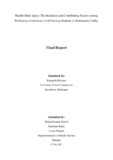Please use this identifier to cite or link to this item:
https://hdl.handle.net/20.500.14356/724Full metadata record
| DC Field | Value | Language |
|---|---|---|
| dc.contributor.author | Paudel, Binita Kumari | |
| dc.contributor.author | Karki, Kanchan | |
| dc.contributor.author | Dangol, Leena | |
| dc.date.accessioned | 2013-08-18T23:08:07Z | |
| dc.date.accessioned | 2022-11-08T10:19:04Z | - |
| dc.date.available | 2013-08-18T23:08:07Z | |
| dc.date.available | 2022-11-08T10:19:04Z | - |
| dc.date.issued | 2013 | |
| dc.identifier.uri | http://103.69.126.140:8080/handle/20.500.14356/724 | - |
| dc.description.abstract | An academic institution based cross- sectional survey was done to identify the incidence density of needle stick injury and its contributing factors among PCL level nursing students. Multi stage sampling method was used to select 407 samples from nursing students studying inside Kathmandu valley. Self administered questionnaire and review the records guideline were used as research tool. Incidence density was calculated and logistic regression model was fitted by using R software. Out of total students participated in the study, 46.9 % had already experienced NSIs and 44.7% of them experienced it more than once. The overall incidence density was found 5.82/person 1000 days exposure. Incidence density in night shift (6.86) and in second year (6.91) practicum period was found higher than morning +evening shift (5.41) and first year (4.21). Number of clinical posting days, year of study, universal precaution practice, vaccination and duty shifts were found associated with needle stick injury. Unexpectedly, college was also found significantly associated with needle stick injury. Out of total 298 injuries included for further analysis, 67.8 % were happened during medication, 41% while drawing medicine, 20% while recapping the needle and 45.1 % at medical ward. Only 46.6% injuries were reported and prophylaxis was used only in five injuries. However almost all the students (98.3%) stated that they follow universal precaution but only 28% practicing no-recapping. There is a practice of reusing syringe; therefore 31.3% stated that needle should recap properly by using one hand technique for the prevention of needle stick injury. Therefore, it is recommended that content in the curriculum and universal precaution training should revise in the context of Nepal and include the process of safe recapping the needle if it is necessary to reuse. It is also recommended to develop Standard Operating Procedure for proper post exposure management of needle stick injury. | en_US |
| dc.language.iso | en_US | en_US |
| dc.publisher | University Grants Commission | en_US |
| dc.subject | Needle Stick Injury | en_US |
| dc.subject | Kathmandu Valley | en_US |
| dc.subject | Nursing Students | en_US |
| dc.title | Needle stick injury: The incidence and contributing factors among proficiency certificate level nursing students in Kathmandu Valley | en_US |
| dc.type | Technical Report | en_US |
| Appears in Collections: | Post Graduate Grant (PG) Reports | |
Files in This Item:
| File | Description | Size | Format | |
|---|---|---|---|---|
| 691.pdf | Full Report. Download | 1.33 MB | Adobe PDF |  View/Open |
Items in DSpace are protected by copyright, with all rights reserved, unless otherwise indicated.
